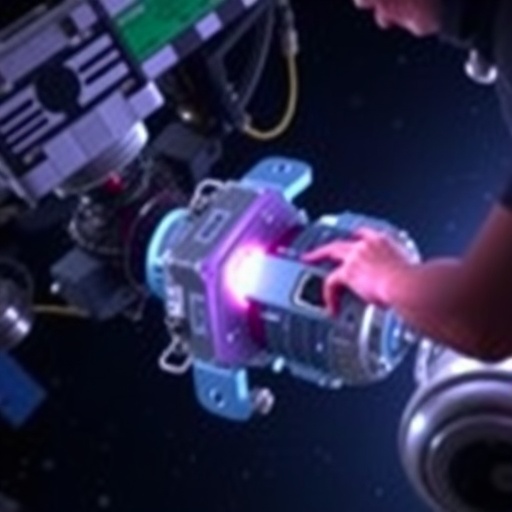New research has shed light on an innovative approach to executing cardiopulmonary resuscitation (CPR) in the unique context of microgravity experienced during spaceflight. This is particularly significant as treating cardiac arrest in such environments poses numerous challenges—both the rescuer and the victim are subjected to weightlessness, complicating the execution of effective chest compressions. Traditionally, the recommended method for performing CPR in space has been the handstand technique, wherein the rescuer assumes an inverted position against the spacecraft to exert the necessary pressure for compressions. However, recent findings suggest that a mechanical solution could provide a more effective alternative.
The groundbreaking study was carried out aboard the modified A310 aircraft, dubbed the “flying laboratory,” operated by the Centre National d’Études Spatiales (CNES), France’s national space agency. This unique aircraft enables researchers to replicate the microgravity environment experienced in space by executing parabolic flight maneuvers, creating brief periods of weightlessness—approximately 22 seconds per parabola. Over the course of three flights, researchers rigorously tested CPR methods using a specially designed floating manikin, monitoring various metrics critical for effective resuscitation.
One of the principal conclusions drawn from this research is that an automatic chest compression device, specifically a standard mechanical piston device, vastly outperformed traditional methods in terms of achieving the required compression depth to sustain blood flow to vital organs such as the brain. CPR guidelines globally recommend that compressions reach a depth of between 50 to 60mm to be effective. Alarmingly, existing techniques did not meet this criterion. The handstand method achieved a mere 34.5mm, while other proposed methods ranged even lower—reinforcing the urgent need for a more reliable solution in scenarios of cardiac arrest during manned spaceflight missions.
In contrast, the automatic device tested in this study made significant strides, achieving a median compression depth of 53.0 mm, thus aligning more closely with the effective depth criteria outlined by health organizations such as the European Resuscitation Council. The performance differences were stark and underscored the inadequacies of traditional CPR methods in settings where the laws of physics vary greatly from Earth’s standard environment. The findings suggest a paradigm shift in how space agencies might approach emergency medical preparedness for future missions.
The implications of these results extend beyond mere theoretical interest; they may profoundly influence future guidelines for managing medical emergencies in space, particularly as humanity stands poised to embark on longer-duration missions, including potential Mars exploration and the burgeoning field of space tourism. These future endeavors could heighten the likelihood of medical complications manifesting among astronauts—individuals historically regarded as young, healthy, and fit due to stringent pre-mission health screenings.
But the study’s challenges aren’t solely technical—how spacecraft can accommodate additional equipment, such as the automatic chest compression devices, poses a logistical dilemma. Space agencies must navigate weight restrictions and spatial constraints within their vessels while factoring in the life-saving potential these innovations offer. Mr. Nathan Reynette, a representative from the study team, emphasized that decisions on whether to implement automatic compression devices will ultimately rest with individual space agencies, constrained by a complex interplay of factors including mission objectives, operational costs, and overarching safety protocols.
Moreover, the research highlights broader applications for automated CPR technology beyond the confines of space travel. Isolated environments, such as submarines and Arctic research stations, similarly encounter challenges in delivering effective CPR due to spatial and operational constraints. The insights garnered from this space-related study could very well pave the way for enhanced medical protocols in these settings.
The rigor and innovation of this research signal a pivotal moment in the realm of space medicine, a field that continually seeks to translate findings into actionable medical protocols that can ensure astronaut safety in various environments. As such environments evolve and include more diverse populations, including tourists and commercially-operated missions, the stakes of effective emergency response will only continue to escalate.
As the scientific community eagerly awaits the incorporation of this critical research into next-generation CPR guidelines for space travel, one thing remains abundantly clear: the future of emergency medicine in space will rely heavily on innovation, technology, and a willingness to rethink established protocols. The early results from this study serve as a call to action for further research and development, reinforcing the notion that as we reach for the stars, our approach to life-saving techniques must keep pace with our ambitious ventures into the cosmos.
In conclusion, the innovative development of automated chest compression devices showcases the potential for science and technology to revolutionize practices that have remained static for decades. The prospect of redefining how we perform CPR in space not only enhances astronaut safety but also introduces a new frontier of possibilities for medical responses in extreme environments on Earth. The commitment to advancing this research could be the lifeline that ensures both the safety of astronauts and the effectiveness of emergency medical services as we collectively venture further into the universe.
Subject of Research: Automatic Chest Compression for CPR in Space
Article Title: New Innovations in CPR Techniques for Spaceflight
News Publication Date: 27 August 2025
Web References: German Society of Aerospace Medicine
References: European Resuscitation Council Guidelines
Image Credits: N/A
Keywords
Cardiopulmonary Resuscitation, Space Medicine, Microgravity, Automatic Devices, Chest Compressions, Research, Emergency Protocols, astronaut health, innovative technology.




